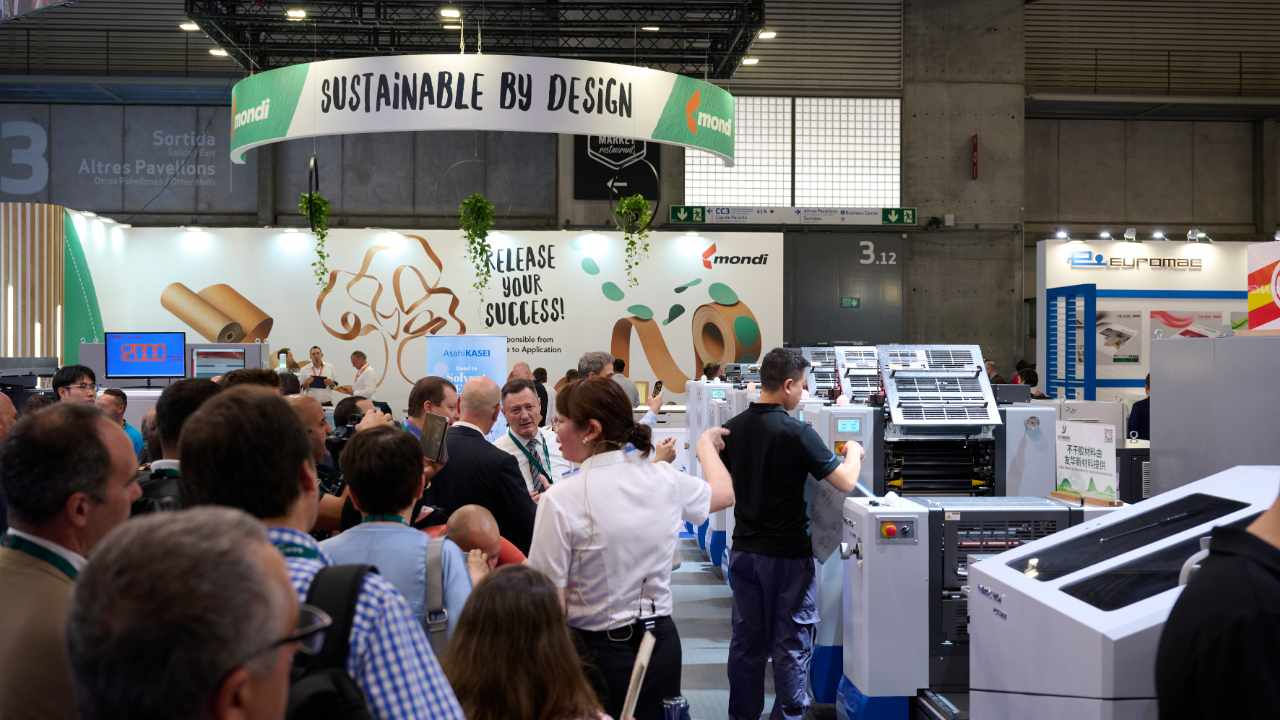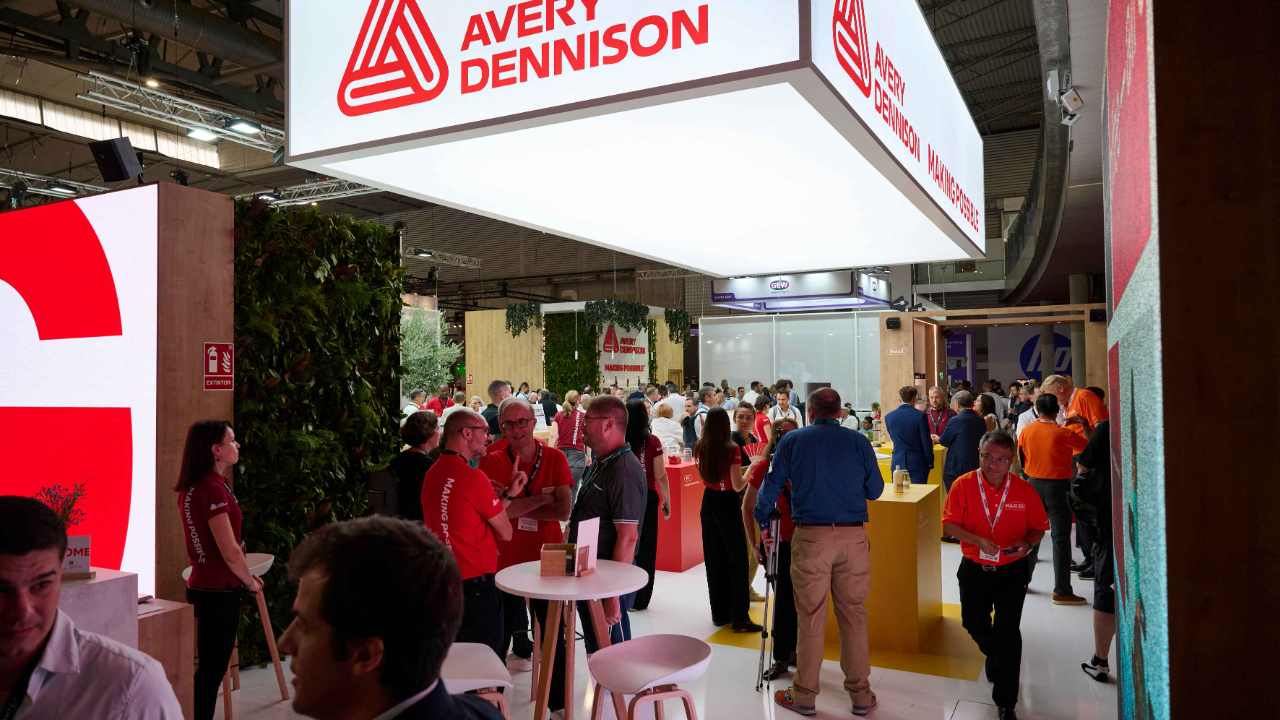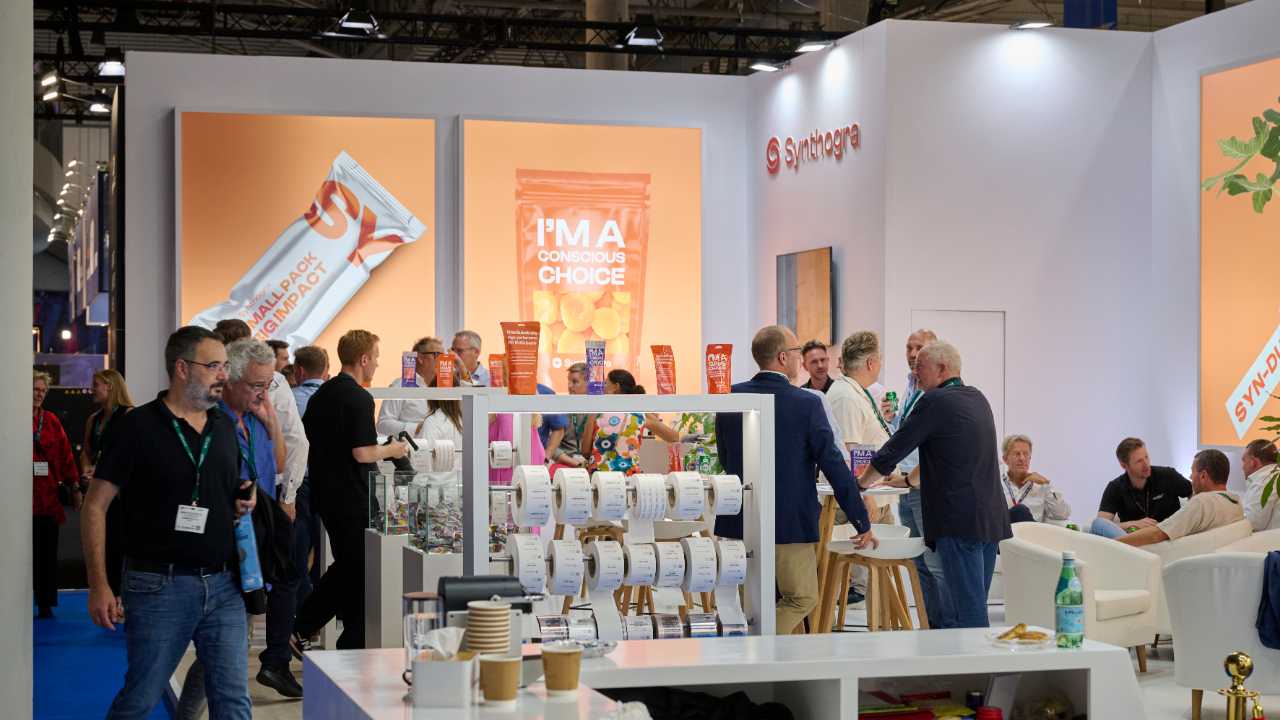Labelexpo Europe 2025: Materials
At Labelexpo Europe 2025, the focus of the materials scientists was on innovation while complying with upcoming sustainability regulations.

The overarching theme of material suppliers at Labelexpo Europe 2025 was clear: every component of a pressure‑sensitive label, from the release liner to the final adhesive bond, is being redesigned to meet the demands of a circular economy.
The industry demonstrated its response to global mandates like the EU’s Packaging and Packaging Waste Regulation (PPWR) and the Deforestation Regulation (EUDR).
Sylwia Jurys, vice president, markets EMEIA at UPM Adhesive Materials, highlights the regulatory pressure driving these developments: ‘Selecting the right label is essential to elevate sustainability, especially now as the EU’s PPWR
requirements place even more pressure on packaging.’
On the same note, Günther Birkner, president of Innovia Films, shares: ‘Our strategy is clear: renovate, localize and decarbonize label film solutions for a market where sustainability and performance can no longer be mutually exclusive.’
Recyclable and PCR materials
The biggest trend at the exhibition was the rapid commercialization and scaling of label materials utilizing post-consumer recycled (PCR) content. This represents a critical shift from simply producing recyclable labels to producing labels that support the recycling of the entire package.
Avery Dennison emphasized its commitment to circularity with a portfolio centered on solving key recycling challenges. The company introduced PET labels with chemically recycled content for the automotive and durable goods sectors, a move aimed at meeting specific OEM requirements where performance cannot be compromised. The automotive industry, for instance, requires high durability, which recycled content previously struggled to match.
Beyond films, Avery Dennison also promoted AD CleanFiber, an INGEDE12‑certified paper label range utilizing a new adhesive technology that cleanly separates during the recycling process, ensuring higher-quality pulp for paper and cardboard production.
UPM Adhesive Materials dedicated significant resources to innovations that enhance logistics and consumer durables through sustainable materials. The company launched new products featuring solvent-free adhesives and PET PCR materials, simplifying decision-making for brands that require labeling modern appliances with multiple tags for energy ratings and QR codes.
‘Our decisive efforts have enabled strong and measurable progress on our 2030 climate commitments. Moving forward, we will increasingly concentrate on delivery to our customers, investing in our LCA and Scope 3 services and in reducing the carbon footprint of our products. By collaborating with our partners and keeping our ambition to meet our climate goals, we can reduce impact at scale,’ states Robert Taylor, director, global sustainability at UPM Adhesive Materials.
UPM emphasized that its Carbon Action plastic label materials assist brands in demonstrating quantifiable reductions of their carbon footprint.
The shift was equally visible in the synthetic film producers. Innovia Films showcased its Encore range of sustainable films, which integrates up to 35 percent mechanically recycled content. These films maintain the high optical clarity, barrier performance and durability expected for both food and non-food applications, providing converters with a practical path toward decarbonization.
Simon Huber, managing director of Innovia Films Europe, notes that the material changes are a response to regulatory pressure, confirming that the company is delivering ‘materials aligned with circular economy goals like the PPWR’.
The company also debuted the next-generation BOPP label films that are thinner and lighter, reducing raw material usage while maintaining print quality.
Similarly, Taghleef Industries presented its Dynamic Cycle Solutions, an offering designed to support brands transitioning from multi-layer plastic structures to more sustainable materials, with a focus on bio-based, biodegradable and recycled polypropylene options.
Ambra Stocco, European marketing and communication manager and label lead at Taghleef Industries, acknowledges the foundational industry change: ‘Even in 2025, the packaging industry continues to be in the midst of transformation, urged on by increasing demands for new, more sustainable solutions that comply with new regulations.’
The company’s reDesign service assists partners in creating customized technologies that comply with PPWR guidance, demonstrating that sustainability must be engineered at the design stage.
“The evolving EU regulatory environment is not a limitation. It’s an invitation to innovate more boldly”
Polyart Group, specializing in papers and films, showcased its r-range of products, including r-Polyart, an HDPE film containing 30 percent PCR HDPE, specifically designed to meet the EU 2030 packaging target for recycled content. For paper-based applications, its r-JetPrint Aquaskin uses 100 percent recycled paper with unique barrier coatings, targeting markets like wine labels that require both sustainability and elegance.
Fedrigoni Self-Adhesives mirrored this commitment with its Re-Play Tintoretto product, a premium wine labeling material made from recycled fibers, reinforcing the integration of post-consumer materials into high-end aesthetics. For demanding industrial applications like tire and pharmaceutical labeling, Fedrigoni featured materials with chemically recycled content, ensuring durability and optimal end-of-life outcomes.
Even components outside the label laminate itself are seeing high recycled content integration. Ahlstrom debuted its Acti-V RF liners, which utilize 15 percent post-consumer recycled (PCR) fibers in its manufacturing, and the Acti-V RF Natural liners, a blend of at least 50 percent unbleached and 15 percent PCR fibers.
Elkem launched Silcolease Re Poly 11362 and Silcolease Re Poly 368, two additions to its silicone range that are 100 percent recycled silicone-based and solvent-free. Developed using a patented depolymerization technology, these products have a 70 percent lower carbon footprint than their non-recycled counterparts while delivering identical technical performance.
Linerless labels
The linerless label segment was one of the most dynamic areas of material innovation, driven by the clear objective of eliminating the single largest source of label waste: the release liner. Moving beyond simple logistics applications, the new products focused on reliable adhesive performance, high-speed dispensing and application diversity.
Herma was a key player in this space, promoting its Herma InNo-Liner system. This technology focuses on eliminating liner waste and reducing associated logistics costs. The technology features the unique 82S adhesive, which is only activated at the moment of dispensing and then immediately and permanently sticks to the substrate.
According to the company, the complete elimination of this residue also means the complete elimination of the previously necessary and expensive disposal or recycling processes. Users, print shops and the environment can also rejoice for other reasons: because there is no liner, more labels fit on a roll, which in turn are easier to transport and take up less space in the warehouse.
Lintec expanded its linerless offering with a novel approach for packaging and logistics. The company showcased a linerless sealing tape that uses water-activated adhesive applied directly to the base material. This product merges shipping information with the sealing function, cutting label consumption and eliminating liner waste. Lintec highlighted that a key benefit is the secure detachment of address details to safeguard personal data upon removal.
HB Fuller supported the linerless trend with specialized adhesive technology, featuring its Gel-Tac Linerless technology. This is part of its microsphere adhesive range, engineered for self-wound products where residue-free removal and consistent adhesion are crucial throughout the product lifecycle. It expands the application of linerless technology beyond logistics to consumer products that require repositionability.
“Selecting the right label is essential to elevate sustainability, especially now as EU’s Packaging and Packaging Waste Regulation requirements place even more pressure on packaging”
Henkel Adhesive Technologies showcased high-performance PSA adhesive products specifically developed for linerless label applications, noting that they ‘reduce the amount of material used and increase process efficiency in label printing.’ Philippe Daval, head of market strategy packaging Europe at Henkel Adhesive Technologies, underscores the significance of holistic problem-
solving: ‘Companies aiming to remain competitive must address sustainability, performance and regulation as a whole and work with partners from the industry to overcome the challenges.’
Compostable materials
While recyclability remains the dominant pursuit, compostable materials were featured to address specific niches, particularly food waste packaging and short-cycle, high-organic-waste applications.
These materials are designed to break down effectively in industrial composting facilities, preventing label residue from contaminating organic waste streams.
Fedrigoni Self-Adhesives featured compostable paper and film alternatives prominently in its portfolio. These products target applications where the label and the package contents (like food) are disposed of together, or where recycling infrastructure is weak but composting is available.
Polyart Group introduced Fiberskin Tag, an innovative 100 percent paper that is not only recyclable and biodegradable but also compostable. This material offers excellent tear resistance, making it suitable for demanding applications like plant tags, while adhering to environmental end-of-life standards, the company says.
Mondi showcased its broader commitment to sustainable packaging with its FunctionalBarrier Paper Ultimate. While primarily a high-barrier paper for flexible packaging, its underlying material science principles, focused on paper-based structures with high functionality, inform the future of paper label substrates. This development supports the push for monomaterial paper packaging, where labels must be easily repulpable or fully compostable.
Global Label Award winner for sustainability, Bio4Life exhibited its certified range of film and paper face stocks paired with its BioTAK home-compostable adhesive. It emphasized the necessity of using a fully certified laminate structure (face, adhesive and liner) to ensure the entire label breaks down efficiently. Bio4Life directly addressed the challenge of fruit and vegetable labeling by offering products that safely enter the organic waste stream without contaminating it.
Wash-off labels
Wash-off label technology was a significant focal point, as it directly supports two crucial industry goals: enhancing the quality of recycled resin (especially PET) and enabling container reuse (particularly for glass bottles). The separation of the label from the container during the washing phase of recycling is non-negotiable for achieving high-grade recycled materials.
Avery Dennison presented an expanded AD CleanGlass portfolio, including a new white film option, developed for reusable glass packaging. The clear and white versions are engineered to wash off completely in a conventional bottle washer at 80 deg C. This development is key to supporting brand-owner mandates for refillable and reusable glass bottles.

Herma highlighted its advanced wash-off adhesive, which is engineered to ensure a 100 percent film label wash-off rate for PET bottle recycling. This level of clean separation is essential to prevent contamination of the PET flake stream, which is then reprocessed into new bottles.
Henkel demonstrated its leadership in adhesive science with its recyclable pressure-sensitive adhesives showcased under the theme ‘Enabling circularity in labels with adhesives and coatings.’ The company’s wash-off PSAs are designed for PET bottles and can be removed without residue, even at lower temperatures, which helps save energy in the recycling process. This line includes Aquence PS 3017 RE, which was a recognized award winner, underscoring the performance aspect of sustainable adhesives.
HB Fuller offered multiple adhesives for the wash-off requirement. Its Fulltak SE 8308 is a water-based adhesive offering best-in-class cold water wash-off performance, enabling the clean removal of paper labels from various substrates. For glass, particularly beer and wine bottles. Fulltak SE 8306 is designed for alkali wash-off while maintaining ice water resistance for chilled products. The company stresses that its wash-off adhesives ‘support sustainable solutions for both plastic and glass packaging, enabling paper and filmic labels to be cleanly removed across a wide range of surfaces.’
Security and durability
While sustainability dominated the show, brand protection and product integrity remained critical drivers for material innovation, especially in pharmaceuticals and durable goods. This area involved using advanced substrates and unique material compositions to ensure traceability, resistance and anti-counterfeiting measures.
Avery Dennison addressed brand protection and durability for sensitive products with a UV Barrier film label range for pharmaceuticals. This clear film protects UV-sensitive medicines while maintaining high transparency, allowing healthcare professionals to inspect the contents visually.
Additionally, in the durable goods and electric vehicle battery sectors, the company’s chemically recycled PET labels can incorporate features such as flame retardancy and be combined with RFID technology to support complete product traceability and authentication.
“The material changes are a response to regulatory pressure, confirming that the company is delivering materials aligned with circular economy goals like the PPWR”
The focus on high-performance films was evident across other suppliers. Lintec showcased materials specifically for medical and pharmaceutical applications, including specialized skin-contact tapes from its Mactac group. The launch of Re Chill, a removable label material for chilled applications like food and logistics, also contributes to product integrity by adhering reliably in cold, damp, or oily environments, yet remaining easily removable to facilitate recycling.
Nobelus focused on premium aesthetic and brand differentiation through its specialty finish films for prime labels. Its portfolio, which includes soft-touch, prismatic holographic patterns, and other unique effects, is vital for brands aiming for high-end shelf stand-out and perceived quality, both of which are forms of brand protection. These unsupported films provide a high-quality finish required for demanding brand specifications.
PSA innovation
The adhesive segment is the linchpin of label performance and sustainability. Beyond wash-off capabilities, material suppliers aggressively launched new pressure-sensitive adhesives, prioritizing water-based, solvent-free and high-performance options for all major label categories.
HB Fuller emphasized its water-based expertise, launching Swifttak PS 8405, a water-based PSA with non-water whitening properties. This is essential for achieving the popular ‘no-label look’ on PET containers, offering superior clarity and resistance to water whitening, a crucial performance feature for beverage and personal care brands.
Henkel Adhesive Technologies focused on reducing the environmental impact of its production process alongside product performance. Henkel also promoted its UV-curable PSAs, which offer high energy efficiency during the curing
process and strong resistance for demanding applications like the medical sector.
Herma’s material innovations, such as the linerless adhesive, are rooted in advanced PSA engineering. The company’s comprehensive expertise covers the entire self-adhesive chain, which means its new wash-off PSAs are designed to function optimally with its own film and paper substrates, achieving the highest performance standards for PET recycling.
VPF emphasized its role as a flexible partner and specialist in non-standard materials and adhesives. Its VPF Modular System allows for a combination of over 400 facestocks with over 30 specialty adhesives, including permanent, removable, hotmelt and special products like UV-Acrylics and pasteurizable grades.
It confirmed its commitment to sustainability with a focus on ‘innovative, flexible and versatile’ products, including those with wash-off properties and durable performance for extreme conditions.

Sappi contributed significantly to the infrastructure supporting PSAs with its specialty papers for release liners. Its new Sol BCK liner is a CCK paper designed to replace traditional PCK papers, promising a greatly improved carbon footprint by eliminating plastic coating and improving recyclability.
The company emphasized that this technology offers ‘significant cost savings’ alongside sustainability benefits, providing the crucial base material for the PSA industry to advance its own circularity goals.
Weight reduction
Beyond recycled content, the drive to use less material without compromising integrity was evident through the broad adoption of down-gauged films and monomaterial constructions. Suppliers exhibited a focus on BOPP, PE and PET films that are thinner and lighter, directly translating to lower raw material consumption and lower transport emissions.
Innovia Films explicitly linked its investment in new European extrusion technology to the ability to produce thinner, lighter, and higher-clarity films like CPE and WPE, which significantly reduce the carbon footprint.
Simon Huber, managing director of Innovia Films Europe, notes that the material changes are a response to regulatory pressure, confirming that the company is delivering ‘materials aligned with circular economy goals like the PPWR.’ The development of RayoFloat, a low-density material that floats in recycling wash tanks, ensuring clean removal and preventing contamination of the PET stream, highlights the engineering focus on end-of-life performance for filmic substrates.
Taghleef Industries focused on lightweight materials to save significant resources, ensuring that the minimalist and functional design of its flexible films does not compromise protection or aesthetics. The films are designed to meet a
wide range of demanding applications, from food to cosmetics, demonstrating the industry’s ability to combine performance with resource efficiency.
The company unveiled three new films at the show. Rather than presenting them in a conventional format, the company displayed each as a work of art. Shape360 TDSW is a white film for TD shrink sleeve labels, specifically developed for light-sensitive products. It also launched a new decorative film substrate. And finally, an innovative detachable in-mold label film technology that is widely used for decorating rigid PP containers. The key breakthrough is the film’s detachability, which is fully aligned with the PPWR and RecyClass guidelines.
Stocco shares: ‘The evolving EU regulatory environment is not a limitation, it’s an invitation to innovate more boldly. These films represent not just product advancements, but a new mindset around what labeling and packaging solutions can achieve.’
Mondi’s paper-based products, such as the high-barrier paper, represent a shift toward maximum functionality in a mono-material paper structure, capable of replacing multi-layer plastic or aluminum. This development underscores the overall trend towards simplification of materials to improve the effectiveness of recycling processes, a goal shared by the label and flexible packaging sectors.
Armor Iimak, focusing on thermal transfer media, launched the AWR XL wax ribbon, which features the thinnest 3.35 micron PET film in the industry. While a separate component, this innovation directly contributes to the industry’s goal of material reduction, resulting in up to 26 percent less plastic waste per roll. This highlights the industry-wide commitment to down-gauging across all components of the labeling process.
Aluminum Feron focused on materials engineered for durability and specialized operational requirements across various industrial and tracking applications. The company featured its range of durable substrates for labels and tags, including specialized substrates like Tritex, which are engineered for extreme durability, metal detectability in certain food production environments, or for integration with RFID protection in logistics and asset tracking.
“Companies aiming to remain competitive must address sustainability, performance and regulation as a whole and work with partners from the industry to overcome the challenges”
Comercial Arque highlighted its range of specialty aesthetic papers and films targeted at the premium branding segment. Its focus was on materials that provide unique tactile sensations or visual effects (such as deep embossing or holographic finishes) while ensuring compatibility with high-speed digital printing technologies, allowing luxury brands to achieve differentiation in short print runs.
Fangda Packaging presented its diverse portfolio of flexible packaging and label materials, with a specific emphasis on high-barrier mono-material solutions. Its focus was on enabling the conversion of multilayer, non-recyclable flexible packaging structures into simpler, label-friendly formats that maintain the necessary oxygen and moisture barriers for fresh food applications.
Frimpeks showcased its comprehensive position as a supplier of inks, coatings, and labelstock, demonstrating how the three components can be optimized for challenging applications. It featured a range of UV-curable PSAs and coatings designed to provide superior chemical and abrasion resistance for durable industrial and automotive labels, ensuring compliance and longevity in extreme conditions.
Hueck Folien, known for its expertise in high-security and holographic materials, introduced new anti-counterfeiting filmic substrates for labels. These materials integrate micro-text, visible, and invisible security features directly into the film structure, making them essential for high-value goods, pharmaceuticals, and duty stamps, protecting brand integrity while remaining compatible with standard label converting processes.
Jinya Label highlighted its specialty in thin-gauge, high-yield label face stocks. Its exhibit focused die-cutting and dispensing, particularly in the thermal paper and direct thermal film segments, by optimizing material thickness and coating chemistry for maximum efficiency.
MLJ Industries focused on industrial and automotive applications, showcasing durable film and foil materials designed to withstand engine oils, brake fluids and sustained high temperatures. It presented a new high-adhesion, chemical-resistant acrylic adhesive that maintains its bond strength on low-surface energy plastics and metal surfaces, even under prolonged exposure to harsh conditions.
Synthogra introduced its pioneering approach to flexible packaging and label films through its High-Barrier One-Substrate Film. This technology addresses material reduction and recyclability in one product. By offering a true mono-material composition in a high-barrier format, Synthogra minimizes complexity in the recycling stream.

Talking more about the products, Nanette Thomas comments: ‘At Synthogra, performance, productivity and responsibility go hand in hand. One example is our Syn-Durable, a product we continue to refine. It delivers speed and efficiency on the press while also reducing plastic use by adding more than 40 percent minerals. The result: less plastic, without compromising quality or productivity. This is how we combine high performance with responsibility.’
Yupo introduced its latest highly sustainable synthetic paper grades. These new materials are designed to be fully recyclable where a mono-material polypropylene stream is established. Yupo focused on its enhanced surface treatments that ensure superior print fidelity and fast-drying times for both UV inkjet and HP Indigo digital presses, maintaining the durability and water resistance that synthetic paper is known for.
Engineered material science
Labelexpo Europe 2025 confirmed that the label industry is undergoing a profound transformation, moving from incremental improvements to engineered material technologies that address the mandate for circularity. The showcased materials, from chemically recycled PET films and PCR-content papers to wash-off adhesives and the complete elimination of waste through linerless systems, all reflect a cohesive strategy.
Stay up to date
Subscribe to the free Label News newsletter and receive the latest content every week. We'll never share your email address.


